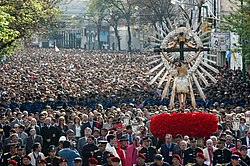This article needs additional citations for verification. (April 2022) |
A Holy Week procession is a public ritual march of clergy and penitents which takes place during Holy Week in Christian countries, especially those with a Catholic culture. Various images of the saints, especially the Virgin Mary, and most importantly the image of the crucified Christ are carried aloft by foot on shoulder-borne pasos (or on wheeled carrozas in the Philippines) as an act of penance; acts of mortification are carried out; traditional Christian hymns and chants are sung (except during the silent processions of Good Friday). In many confraternities of penitents, the faces of the members are covered by elaborate hoods, such as the capirote, as a way of hiding one's identity in order to not ostentatiously draw attention to oneself while performing penance. Crosses, and biers holding Catholic holy images surrounded with flowers and offerings of candles, are carried usually from one parish church to another led by the clergy, monastic orders, or heads of the penitential orders.[1]

Holy Week processions
edit- Palm Sunday: The day when Jesus arrived in Jerusalem.
- Holy Thursday: The day when Jesus shared the Last Supper with His Apostles, followed by the beginning of his Passion.
- Good Friday: Jesus' crucifixion, performed in 14 stations.
- Holy Saturday: Loneliness of the Blessed Virgin Mary and the day that Jesus Christ's body lay in the tomb.
- Easter Sunday: The resurrection of the Christ.
Local customs
editArgentina
editColombia
editCorsica
edit- Calvi, Sartène (See Catenacciu )
Guatemala
editHonduras
editItaly
editTrapani, Taranto, Chieti, Sulmona,
Malta
edit- Citadel (Gozo)
- Cospicua
- Għargħur
- Għaxaq
- Luqa
- Mosta
- Nadur
- Naxxar
- Paola
- Qormi
- Rabat
- Valletta
- Victoria (Gozo)
- Vittoriosa
- Xagħra (Gozo)
- Xewkija (Gozo)
- Żebbuġ
- Żebbuġ, Gozo
- Żejtun
Mexico
editPeru
editPhilippines
editPortugal
editSpain
edit- Cuenca, declared of International Tourism Interest
- Zaragoza, declared of international tourism interest
- Jerez de la Frontera, declared of National Tourism Interest
- Granada, declared of international tourism interest[4]
- Málaga[5] declared of international tourism interest
- Seville,[6] declared of international tourism interest
- León, declared of international tourism interest [1] Archived 2007-03-11 at the Wayback Machine
- Salamanca, declared of international tourism interest
- Valladolid, declared of international tourism interest
- Zamora, declared of international tourism interest
- Hellin, declared of international tourism interest
- Toledo, declared of international tourism interest
- Murcia, declared of national tourism interest, the typical with Francisco Salzillo images.
- Cartagena, declared of international tourism interest
- Lorca, declared of international tourism interest
- Ferrol, declared of international tourism interest in 2014 [2]
Venezuela
editNoted sculptors of Holy Week pasos
editSee also
editReferences
edit- ^ Taylor, Alan. "The Rituals and Traditions of Easter and Holy Week", The Atlantic, April 2m 2018
- ^ Semana Santa in Popayán
- ^ Semana Santa Andina – Peru (in Spanish)
- ^ La Semana Santa de Granada
- ^ Holy Week in Málaga
- ^ Hafiz, Yasmine. "Penitents Observe Holy Week In Seville, Spain With Processions And Robes", Huffington Post, April 4, 2014